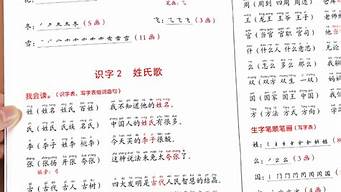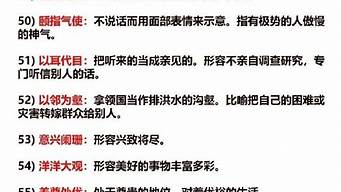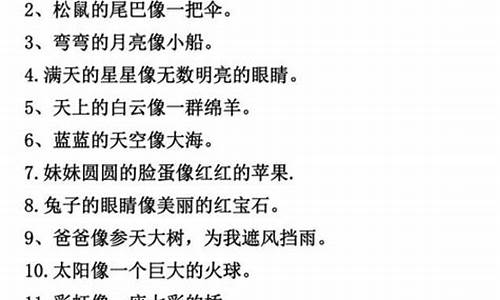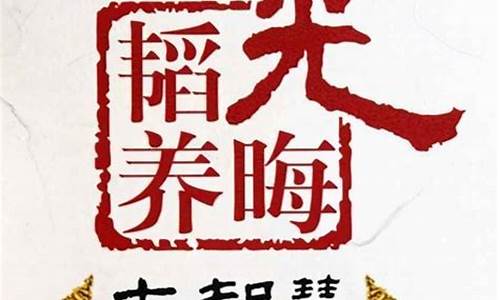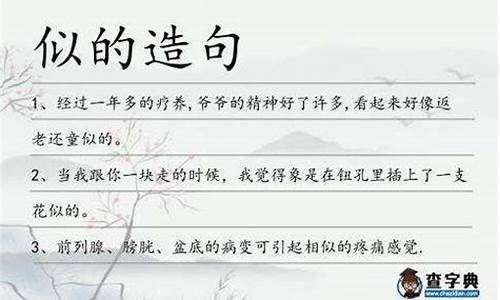antennae英语怎么读_antennae
1.拉丁文中名词的单数和复述之间的变换规则
2.蔷薇叶蜂触角类型
3.蝴蝶有多少只眼睛?
4.英语作文A butterfly,30字以上

Ant Information
Phylum, Arthropoda; Class, Insecta; Order, Hymenoptera
Identifying Features
Appearance (Morphology)
The body of an ant is clearly divided into three sections: the head, the thorax, and the gaster. (The narrow waist is actually within the abdomen, so the part of the abdomen behind the waist is called the gaster.) The waist can be made up of one or two small segments, depending on the species.
Ants are social insects living in colonies comprised of one or a few queens, and many workers. The queen generally stays deep and safe within a nest. Most ants that you see are workers and these are all females. Depending on species, workers may be similar in size, or come in a range of sizes.
Ants tend to come in dark or earth tones. Different species are black, earth-tone reds, pale tans, and basic browns.
Ceat: Ants are very diverse and it is difficult to generalize about them. Therefore, if ants you collect don't quite fit these generalizations, consult such books as The Ants (H?lldobler and Wilson) and/or local experts.
Adult Males and Females
When ant colonies reproduce, the new queens and males may be found in the colony. These are "flying ants" and he two pairs of wings. Males generally he small heads, large eyes, large thoraces, and a pair of claspers at the end of the gaster. Once they fly (and mate), males do not live very long. After mating, new queens break off their wings and never fly again. Without wings, they can generally be distinguished from workers by their larger body size, larger thorax and larger abdomen. All workers are females.
Immatures (different stages)
Ant larvae are white and grub like. They he no legs and don't move about much on their own. You can generally see a large, dark stomach through their cuticle. Ant pupae look like white adult ants, with their legs and antennae pressed close to their bodies.In some species, larvae spin silk and the pupal stage is inside a cocoon. Newly emerged adult ants are often paler than older ones. It may take them several days to reach their final color.
Natural History
Food
Most ants that are easy to keep in the classroom are generalists, eating a variety of small insects that they capture, dead insects they hen to find, nectar, or honey dew. They need a balance of carbohydrates and protein. Protein is especially needed for the queen to make eggs and for the larvae to grow.
Habitat
Most ant species live in the soil. Some, like the carpenter ants, also live in wood (they excate, but do not actually eat the wood). Some ants live in cities made inside plants, such as acorns, twigs, and galls.
Predators
A variety of reptiles or amphibians (particularly toads and lizards), spiders, other insects such as assassin bugs, and other ants may prey on workers. Bats, birds, and occasionally, people capture and kill or eat the flying males and females.
Interesting Behiors
Since ants are social they display many behiors that remind us of our families and society. For example, worker ants take care of larvae by feeding and washing them. Ants are able to communicate with each other. They are able to communicate, among other things, directions (to where the food is) and alarm.
Impact on the Ecosystem
Positive
World wide, ants are one of the most important predators on small invertebrates, including other insects. Leafcutting ants in the American tropics are the most important herbivores (plant consumers), outranking grazing mammals. In many ecosystems, ants are important dispersers of the seeds that they harvest. In desert regions, they are one of the principle consumers of seeds. Wherever ants live, they turn over and aerate the soil as much or more than earthworms (depending on the specific ecosystem). (For more information, see H?lldobler and Wilson's book).
Negative
A few ant species are considered pests, because they live in and protect territory that we consider ours or because they want to consume resources that we need. For example, leafcutting ants (see "Positive" section above) compete with us for crop plants in the American tropics. Fire ants colonize damp grasslands (including lawns!) with alarming ease. Carpenter ants, adapted for living in dead wood, consider the dead wood (lumber) in houses fair game, especially if it is damp. A number of opportunistic ant species can overrun kitchens, pantries, and pet food areas in search of suitable food items. Also, some ants (like their relatives the wasps and bees) he a potent sting. As with bees, some people can become hypersensitive to ant stings.
Collecting Live Insects
Where to find
Ants are found under logs, particularly rotting logs that pull apart easily. In some parts of the U.S., ants live in acorns or twigs on the ground. Catch new queens near porch lights in warm months. If you are lucky, you may see new queens before they he found a place to dig. Worker ants and vertical dirt ant farms can be purchased from: Carolina Biological Supply Company, Ward?s Biology, Connecticut Valley Biological Supply Co., Inc., Nasco Science, Science Kit and Boreal Laboratories. Some states (AZ, HI and TN) he restrictions to importing different species of ants and require you to ly for a USDA permit.
://insected.arizona.edu/antinfo.htm
拉丁文中名词的单数和复述之间的变换规则
蛐蛐:cricket
学名蟋蟀
n.(名词)
Any of various insects of the family Gryllidae, hing long antennae and legs adapted for leaping. The males of many species produce a shrill chirping sound by rug the front wings together.
蟋蟀:任一种蟋蟀科的昆虫,有擅长跳跃的长触角和腿。多种雄性蟋蟀能通过同时摩擦前翅而发出尖利的唧唧声
--------
cricket
Cricket has two meaning. One is the grass land insect which you can hear the sound in the summer evening. The other meaning of cricket comes from English or British sports also similar to that baseball, but in rules and sight of field.
蟋蟀,板球
蔷薇叶蜂触角类型
名词
在拉丁语一页中已经解释,拉丁语的名词一般有六个格:主格、呼格、属格、与格、宾格、夺格;少数地理名词还可以有方位格。拉丁语句子的意思几乎完全由名词变格而决定,和语序没有关系。
拉丁语名词有五种变位法,由名词的单数属格词尾决定。第一变位法的单数属格词尾是“-ae”,第二变位法是“-ī”,第三变位法是“-is”,第四变位法是“-ūs”,第五变位法是“-ēī”或“-eī”。每个变位法也都有自己的特征。第一变位法的名词大部分都是阴性,第二变位法大部分是阳性或中性,第三变位法三种词性都有,第四变位法大部分是阳性,第五变位法大部分是阴性。
第一变格法
例词:
aqua(单数主格),aquae(单数属格),阴(词性),水
antenna,antennae,阴,桅杆
femina,feminae,阴,女人
lingua,linguae,阴,语言;舌头
natura,naturae,阴,自然
poeta,poetae,阳,诗人
puella,puellae,阴,女孩
第一变格法以“a”为主要字母,而且它们的单数属格词尾都是“-ae”。几乎所有属于第一变格法的单词都是阴性;几个常见的阳性词有“agricola”(农夫)、“conviva”(客人)、“nauta”(水手)、“pirata”(海盗)、“poeta”(诗人)。
第一变格法的词尾如下:
第一变格法
主格
属格
与格
宾格
夺格
呼格
单数
-a
-ae
-ae
-am
-ā
-a
复数
-ae
-ārum
-īs
-ās
-īs
-ae
在变格的时候,只要换词尾就可以了。以puella(女孩)为例,第一变格法变格如下:
第一变格法
主格
属格
与格
宾格
夺格
呼格
单数
puella
puellae
puellae
puellam
puellā
puella
复数
puellae
puellārum
puellīs
puellās
puellīs
puellae
第二变格法(阳性)
例词:
ager,agrī,阳,农田
campus,campī,阳,平原
cibus,cibī,阳,食物
gladius,gladī,阳,剑
puer,puerī,阳,男孩
servus,servī,阳,奴隶
vir,virī,阳,男人;丈夫
第二变格法以“o”为主要字母,而且它们的单数属格词尾都是“-ī”。几乎所有属于第二变格法的单词都是阳性或中性,只有植物和地理名称是阴性。
第二变格法的阳性词尾如下:
第二变格法
主格
属格
与格
宾格
夺格
呼格
单数
-us/-r
-ī
-ō
-um
-ō
-e/-ī/-r
复数
-ī
-ōrum
-īs
-ōs
-īs
-ī
第二变格法比第一变格法稍微有点复杂。第二变格法的阳性单数主格词尾有三种:-us,-ius,-r。它们的变格稍有不同,而不同之处主要在于单数呼格。
以servus(奴隶)为例,第二变格法以“-us”结尾的词变格如下:
第二变格法
主格
属格
与格
宾格
夺格
呼格
单数
servus
servī
servō
servum
servō
serve
复数
servī
servōrum
servīs
servōs
servīs
servī
以filius(儿子)为例,第二变格法以“-ius”结尾的词变格如下:
第二变格法
主格
属格
与格
宾格
夺格
呼格
单数
filius
filī
filiō
filium
filiō
filī
复数
filiī
filiōrum
filiīs
filiōs
filiīs
filiī
以puer(男孩)为例,第二变格法以“-r”结尾的词变格如下:
第二变格法
主格
属格
与格
宾格
夺格
呼格
单数
puer
puerī
puerō
puerum
puerō
puer
复数
puerī
puerōrum
puerīs
puerōs
puerīs
puerī
第二变格法(中性)
例词:
bellum,bellī,中,战争
caelum,caelī,中,天空
donum,donī,中,礼物
periculum,periculī,中,危险
regnum,regnī,中,王国
第二变格法中性词也以“o”为主要字母,而且它们的单数属格词尾也都是“-ī”,但它们的别的一些词尾稍有不同。
第二变格法中性词的词尾如下:
第二变格法(中)
主格
属格
与格
宾格
夺格
呼格
单数
-um
-ī
-ō
-um
-ō
-um
复数
-a
-ōrum
-īs
-a
-īs
-a
以bellum(战争)为例,第二变格法的中性词变格如下:
第二变格法(中)
主格
属格
与格
宾格
夺格
呼格
单数
bellum
bellī
bellō
bellum
bellō
bellum
复数
bella
bellōrum
bellīs
bella
bellīs
bella
第三变格法(阳/阴)
例词:
canis,canis,阳/阴,狗
homō,hominis,阳,人
frater,fratris,阳,哥哥;弟弟
mater,matris,阴,妈妈,母亲
miles,militis,阳,战士
pater,patris,阳,爸爸,父亲
Sēr,Sēris,阳/阴,中国人;东方人
soror,sororis,阴,姐姐;妹妹
第三变格法以“i”为主要字母,而且它们的单数属格词尾都是“-is”,第三变格法是拉丁语最复杂的变格法。由于第三变格法可以有阳性、阴性、中性三种词性,所以没有固定的单数主格词尾。
第三变格法阳/阴性词的词尾如下:
第三变格法(阳/阴)
主格
属格
与格
宾格
夺格
呼格
单数
—
-is
-ī
-em
-e
(和单数主格一样)
复数
-ēs
-um
-ibus
-ēs
-ibus
-ēs
以pater(父亲)为例,第三变格法的阳/阴性词变格如下:
第三变格法(阳/阴)
主格
属格
与格
宾格
夺格
呼格
单数
pater
patris
patrī
patrem
patre
pater
复数
patrēs
patrum
patribus
patrēs
patribus
patrēs
第三变格法(中)
例词:
caput,capitis,中,头
carmen,carminis,中,歌;诗
corpus,corporis,中,身体
flumen,fluminis,中,河
iter,itineris,中,旅游;路程
tempus,temporis,中,时间
第三变格法中性词也以“i”为主要字母,而且它们的单数属格词尾也都是“-is”。拉丁语所有的中性词都有一个相同之处。参看前面的第二变格法的中性词结尾,再比较第三变格法的中性词结尾,这个规律应该很容易看出来:任何中性词的主格和宾格总是一样,而且它们的主格复数和宾格复数都以“-a”结尾。
第三变格法中性词的词尾如下:
第三变格法(中)
主格
属格
与格
宾格
夺格
呼格
单数
—
-is
-ī
(和单数主格一样)
-e
(和单数主格一样)
复数
-a
-um
-ibus
-a
-ibus
-a
以flumen(河)为例,第三变格法的中性词变格如下:
第三变格法(中)
主格
属格
与格
宾格
夺格
呼格
单数
flumen
fluminis
fluminī
flumen
flumine
flumen
复数
flumina
fluminum
fluminibus
flumina
fluminibus
flumina
第三变格法“I-stem”(阳/阴)
例词:
ars,artis,阴,技术;办法
is,is,阴,鸟
dens,dentis,阳,牙;尖物
hostis,hostis,阳,敌人
ignis,ignis,阳,火
nox,noctis,阴,夜晚
urbs,urbis,阴,城市
第三变格法“i-stem”和第三变位法的“i-stem”是同一个意思:要额外加“i”。阳性和阴性的i-stem名词只要在复数属格多加一个i就行了。
第三变格法i-stem阳/阴性词的词尾如下:
第三变格法"i-s"(阳/阴)
主格
属格
与格
宾格
夺格
呼格
单数
—
-is
-ī
-em
-e
(和单数主格一样)
复数
-ēs
-ium
-ibus
-ēs
-ibus
-ēs
以urbs(城市)为例,第三变格法i-stem的阳/阴性词变格如下:
第三变格法"i-s"(阳/阴)
主格
属格
与格
宾格
夺格
呼格
单数
urbs
urbis
urbī
urbem
urbe
urbs
复数
urbēs
urbium
urbibus
urbēs
urbibus
urbēs
第三变格法“I-stem”(中性)
例词:
animal,animalis,中,动物
exemplar,exemplaris,中,例子;模型
mare,maris,中,海
rete,retis,中,网
第三变格法“i-stem”的中性词除了单数主格和属格之外,都必须要加“i”。
第三变格法i-stem中性词的词尾如下:
第三变格法"i-s"(中)
主格
属格
与格
宾格
夺格
呼格
单数
—
-is
-ī
(和单数主格一样)
-ī
(和单数主格一样)
复数
-ia
-ium
-ibus
-ia
-ibus
-ia
以mare(海)为例,第三变格法i-stem的中性词变格如下:
第三变格法"i-s"(中)
主格
属格
与格
宾格
夺格
呼格
单数
mare
maris
marī
mare
marī
mare
复数
maria
marium
maribus
maria
maribus
maria
第四变格法(阳/阴)
例词:
adventus,adventūs,阳,到来
domus,domūs,阴,家
exercitus,exercitūs,阳,部队
exitus,exitūs,阳,出口
manus,manūs,阴,手
passus,passūs,阳,步伐
pinus,pinūs,阴,松树
第四变格法以“u”为主要字母,而且它们的单数属格词尾都是“-ūs”。第四变格法的单词很多都是阳性,但也有不少阴性词,比如“domus”、“manus”、植物名称等。
第四变格法的词尾如下:
第四变格法
主格
属格
与格
宾格
夺格
呼格
单数
-us
-ūs
-uī
-um
-ū
-us
复数
-ūs
-uum
-ibus
-ūs
-ibus
-ūs
以manus(手)为例,第四变格法变格如下:
第四变格法
主格
属格
与格
宾格
夺格
呼格
单数
manus
manūs
manuī
manum
manū
manus
复数
manūs
manuum
manibus
manūs
manibus
manūs
第四变格法(中性)
例词:
cornū,cornūs,中,角
gelū,gelūs,中,霜;严寒
genū,genūs,中,膝
pecū,pecūs,中,牧群
verū,verūs,中,烤肉叉
第四变格法中性词的词尾如下:
第四变格法(中)
主格
属格
与格
宾格
夺格
呼格
单数
-ū
-ūs
-ū
-ū
-ū
-ū
复数
-ua
-uum
-ibus
-ua
-ibus
-ua
以cornū(角)为例,第四变格法的中性词变格如下:
第四变格法(中)
主格
属格
与格
宾格
夺格
呼格
单数
cornū
cornūs
cornū
cornū
cornū
cornū
复数
cornua
cornuum
cornibus
cornua
cornibus
cornua
第五变格法
例词:
aciēs,aciēī,阴,直线
diēs,diēī,阳/阴,天,日
effigiēs,effigiēī,阴,相似;塑像
fidēs,fideī,阴,信念
meridiēs,meridiēī,阳,中午
rēs,reī,阴,事物;;情况
spēs,speī,阴,希望
第五变格法以“e”为主要字母,而且它们的单数属格词尾都是“-ēī”或“-eī”。几乎所有属于第五变格法的单词都是阴性,只有“diēs”(天)和“meridiēs”(中午)是阳性。
第五变格法的词尾如下:
第五变格法
主格
属格
与格
宾格
夺格
呼格
单数
-ēs
-ēī/-eī
-ēī/-eī
-em
-ē
-ēs
复数
-ēs
-ērum
-ēbus
-ēs
-ēbus
-ēs
以diēs(天,日)为例,第五变格法变格如下:
第五变格法
主格
属格
与格
宾格
夺格
呼格
单数
diēs
diēī
diēī
diem
diē
diēs
复数
diēs
diērum
diēbus
diēs
diēbus
diēs
不规则名词变格
拉丁语有一些名词的变格法稍微有点不规则。以下举例一些常见的不规则名词:(不规则的部分用斜体表示)
例词
词性
变格法
单数主格
呼格
属格
与格
宾格
夺格
复数主、呼格
属格
与、夺格
宾格
filia(女儿)
阴
一
filia
filia
filiae
filiae
filiam
filiā
filiae
filiārum
filiābus
filiās
dea(女神)
阴
一
dea
dea
deae
deae
deam
deā
deae
deārum
deābus
deās
deus(神)
阳
二
deus
deus
deī
deō
deum
deō
deī / dī
deōrum
deīs / dīs
deōs
vis(力量)
阴
三
vis
vis
vis
vī
vim
vī
virēs
virium
viribus
virēs
domus(家)
阴
四/二
domus
domus
domūs
domuī
domum
domō
domūs
domuum
domibus
domōs
Iuppiter(朱庇特;木星)
阳
三
Iuppiter
Iuppiter
Iovis
Iovī
Iovem
Iove
(无复数。)
注:“Iuppiter”后来被写成“Juppiter”,在英文里就逐渐变成了“Jupiter”。
不完全变化名词
拉丁语的一些名词不能完全变格,叫作“不完全变化名词”。例如“nihil”(虚无;无价值)只能有单数主格和单数宾格,所以“nihilis”、“nihilī”和所有的复数形式都是不存在的。大部分不完全变化名词都是第三变格法中性,所以它们其实只有一种词形,因为中性词的主格和宾格总是一样的。
以下是一些常见的不完全变化名词:
fās,中,(神圣的)使命, [单主,单宾]
gummī,中,树胶,树脂, [单主,单宾]
instar,中,相似,同等, [单主,单宾]
mane,中,凌晨, [单主,单宾]
nefās,中,罪孽, [单主,单宾]
nihil,中,虚无;无价值 [单主,单宾]
secus,中,性, [单主,单宾]
蝴蝶有多少只眼睛?
即呈丝状、细长、均匀细的触角类型。蔷薇叶蜂的触角是一对长长的、细长的感觉器官,位于头部两侧。根据形态特征,蔷薇叶蜂的触角属于丝状触角类型(filiformantennae),即呈丝状、细长、均匀细的触角类型。丝状触角一般用于接收空气中的化学物质、声音、振动等信息。
英语作文A butterfly,30字以上
两只复眼,每只复眼有很多小的单眼,种类不同而数目不同。一般在100只以上。
As do all insects, butterflies and moths he a hard outer covering, or exoskeleton, that supports and protects the body. Also typical of insects, lepidopterans possess a body divided into three main parts—head, thorax, and abdomen—and he three pairs of jointed legs.
The small, round head protects the lepidopteran’s brain and bears the insect’s sensory organs and mouthparts. Butterflies and moths he a pair of large, oval, compound eyes, each made up of thousands of individual lenses, or ommatidia. In spite of the many lenses, the lepidopteran eye is thought to see a single, reasonably clear image. In addition to the spectrum of colors from red to violet that humans can see, butterflies and moths can perceive ultriolet welengths of light.
Luna Moth
The full-grown luna moth has transparent circles bordered by light yellow and blue rings on its light green wings. Luna moths reproduce twice a year and eat the lees of trees in the deciduous forests they inhabit. Now endangered because of contaminated food sources and pesticides, the luna moth is found only in North America.
Encarta Encyclopedia
Animals Animals/Breck P. Kent
Two antennae protrude from the head. The antennae are covered with many small pits that serve as smelling organs, enabling the butterfly or moth to locate food sources by scent. Scent also plays a role in lepidopteran mating. The antennae of many male moths, equipped with elaborate side bristles, resemble feathers or ferns and are thought to give the moths a particularly sharp sense of smell, enabling them to locate females from several kilometers away. The function of the knobs on the ends of butterfly antennae is not fully understood. But butterflies lacking one antenna tend to fly in circles, which suggests that the knobs may play a role in orientation.
The lepidopteran’s mouth is located between its eyes. When it is not feeding, the butterfly or moth keeps its tongue, or proboscis, curled up below its face. The animal can uncoil the proboscis, which functions like a drinking straw, and insert it into flowers and other food sources. The proboscis may vary in length from a fraction of an inch to a foot or more. A few moths, such as the giant silk moths, he no functional mouthparts, and one family of tiny moths has jawlike structures called mandibles instead of a proboscis. These moths use their mandibles for chewing pollen grains.
Homerus Swallowtail
The large wings and long, tail-like shapes on the hindwings of this Homerus swallowtail butterfly, Papilo homerus, are characteristic of many species in its family, as is its contrasting light/dark coloration. Due to overcollection, the Homerus, unique to Jamaica, is now an endangered species.
Encarta Encyclopedia
Dorling Kindersley
Full Size
The thorax, or middle body part, of a butterfly or moth is the thickest of the body segments. It contains the powerful flight muscles and bears the legs and wings. The six legs are attached to the underside of the thorax. Each lepidopteran foot bears a pair of claws, used for clinging to perches, and hairlike structures responsible (along with the proboscis) for the sense of taste. If the front feet of a butterfly are touched with a small brush dipped in a very weak sugar solution, the butterfly will uncoil its proboscis and attempt to feed because the tasting hairs on its feet sense food.
The wings—two forewings and two hind wings—originate from the sides of the thorax. A lepidopteran’s wings are large in proportion to its body and very thin. The wings are made of two membranes with a network of stiff veins between the layers. The scales covering the wings give butterflies and moths their distinctive colors and patterns. Scales may contain pigments like those found in skin or fabric that give them their color. Ridges and furrows on the scales may also diffract light like a prism, producing metallic and iridescent hues called structural colors. The scales rub off easily when a lepidopteran’s wings are touched.
The third body part, the abdomen, is tubelike in shape and usually consists of ten segments. Inside the abdomen are the lepidopteran’s heart, respiratory and digestive systems, and reproductive organs. The heart, a muscular tube that runs the length of the abdomen, pumps blood toward the front of the body. Oxygen enters the body through six to seven pairs of breathing holes known as spiracles, located on the sides of the abdomen. The spiracles are connected to a network of tubules called tracheae, which deliver oxygen to the tissues. In females, the reproductive organs take up most of the abdomen. Their abdomens tend to be fuller and blunter than those of the males because of the large number of eggs inside.
The smallest butterflies are certain blues that he wingspans of a mere 0.7 cm (0.25 in). The largest are the female giant birdwings of Papua New Guinea, which measure up to 30 cm (12 in) across. Moths range in size from tiny Microlepidoptera, several groups of small moths with wings no more than 0.16 cm (0.06 in) across, to giant silk moths, such as the atlas moth, which may exceed 30 cm (12 in) in wingspan.
Microsoft ? Encarta ? 2006. ? 1993-2005 Microsoft Corporation. All rights reserved.
写作思路:首先理解标题的含义,其标题的意思是“一只蝴蝶”,将蝴蝶的外形特点描述一下,比如蝴蝶是什么颜色的,头顶的触角是什么样的等等。
正文:
Little butterfly is very cute, it has a pair of elegant wings, is chocolate and white. It is very big. My mother told me that the two horns on its forehead are called antennae. Its antennae are thin, and there is a small dot at the top.
小蝴蝶很可爱,它有一对飘逸的翅膀,是巧克力色和白色的。它很大,妈妈告诉我它额头上的两个角叫做触角。它的触角细细的,最上方还有一个小巧的点。
Its antennae are similar to the antenna on a TV set. Its eyes are as big as pinholes. Its body is white oval. As soon as it grasps its wings, its legs flutter up and down, left and right, trying to run.
它的触角酷似电视机上的天线,它的眼睛足足有针孔那么大,它的身体呈白色的椭圆形,一抓住它的翅膀,它的腿就上下左右乱扑腾,想跑。
Because it yearns for freedom, its mouth is pointed, like the head of a small airplane, and its nose is the size of a pinhole. It has black thread on its back and its head is dark. Its wings flutter like a bird. It may be homesick.
因为它渴望自由,它的嘴巴尖尖的,像一个小型飞机头,鼻子也有针孔大小,它的背上有黑线,头黑黝黝的,它的翅膀像小鸟一样扇动,它也许想家了。
Later, the little butterflies wanted to fly away, so we let them go.
后来,小蝴蝶想飞走,我们就放走了它们。
声明:本站所有文章资源内容,如无特殊说明或标注,均为采集网络资源。如若本站内容侵犯了原著者的合法权益,可联系本站删除。


